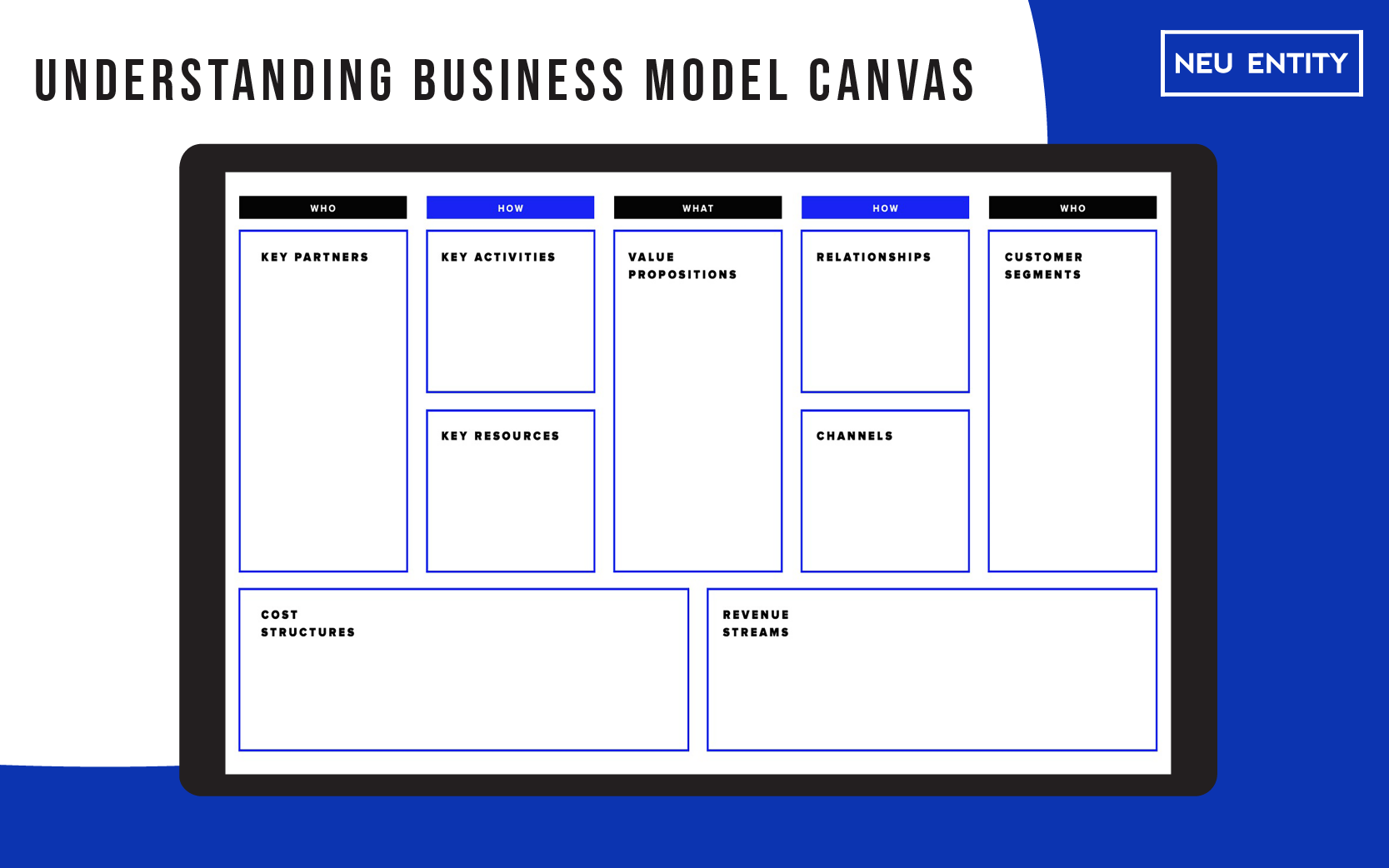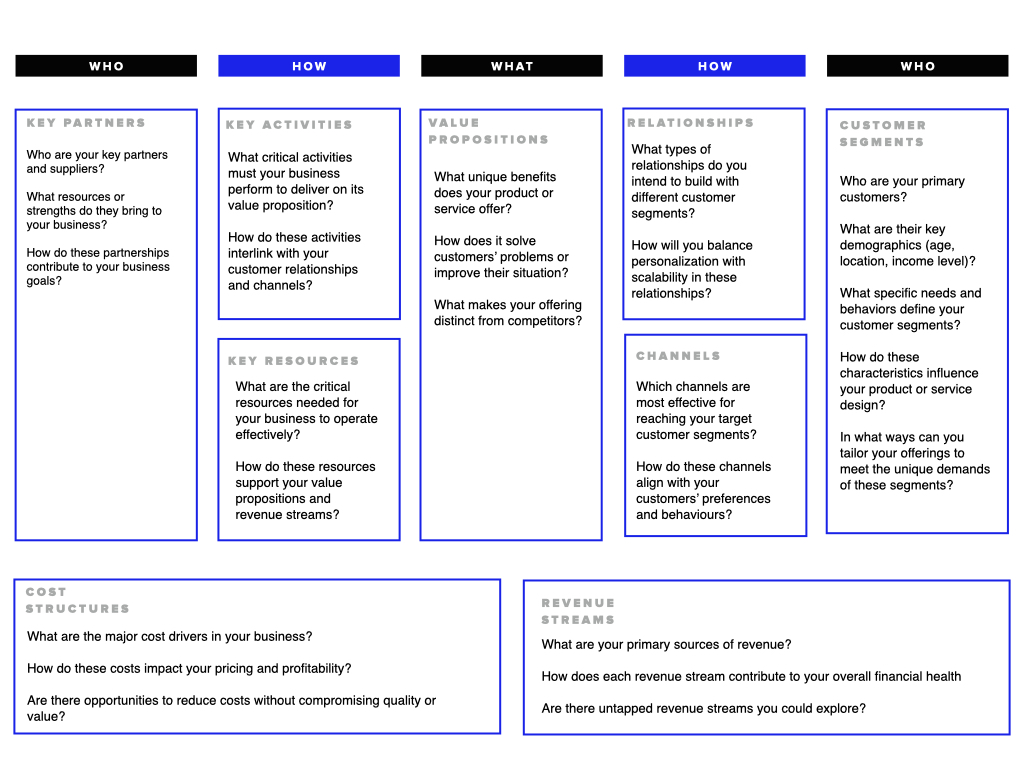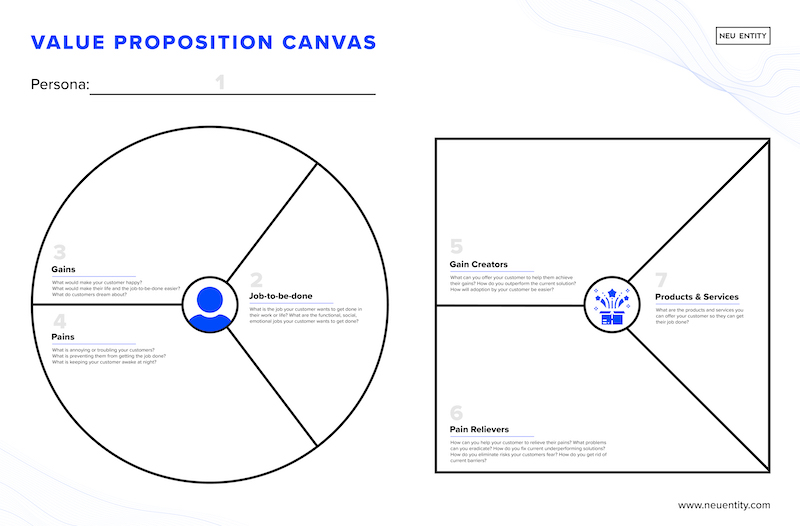Benefits of Business Model Canvas
Last Update: 20 December 2023
In this article, we’ll unravel the benefits of using a business model canvas and show you why it’s the secret weapon every entrepreneur needs. So, grab your compass and let’s dive in!
What is Business Model Canvas?
Business Model Canvas is a powerful tool that provides a structured framework for developing and analyzing business models.
The Business Model Canvas offers a visual chart, encompassing crucial elements of a business such as value propositions, customer relationships, channels, revenue streams, and more.
This tool assists in aligning business activities and understanding potential trade-offs, thereby serving as a comprehensive guide for strategic planning and decision-making.
It was introduced by Alexander Osterwalder and Yves Pigneur in their book “Business Model Generation.”

Benefits of Business Model Canvas for
Your Business
Benefit #1: Quick
It helps you to plan your business concept “Quick”. The advantage of having a business model canvas is that you can get quick glances at what you want and need to set up your business on one sheet of paper. Without it, you might take longer to plan on your business concept, it can take you up to 40 pages or rather hundreds of page reports.
Benefit #2: Overview
It gives you an “overview” of your business plan. You can understand the whole business just by looking at one business model canvas and that’s only possible because you have 9 different segments which are the main point that you need to focus on when wanting to start a business.
Benefit #3: Clarity
The third benefit gives you clarity. As why it gives you clarity is simple, you’re able to look through the whole plan on a zoom out perspective, and often times whenever we do brand strategy for our clients they find clarity at the end of the whole business model canvas part of the reason it gives them a lot more focus on their business and they are very clear on what they want to do next.
Benefit #4: Improved Decision-Making
With its visual nature and comprehensive framework, the canvas enables data-driven decision-making. It provides a structured approach to evaluate different options, compare trade-offs, and select the most viable strategies. This helps you make informed decisions that are grounded in analysis and insights.
Benefit #5: Collaboration and Alignment
The Business Model Canvas serves as a collaborative tool, facilitating discussions and fostering alignment among team members, stakeholders, and partners. It enables everyone involved to contribute their perspectives, share insights, and collectively shape the business model, fostering a sense of ownership and buy-in.
Benefit #6: Customer-Centric Focus
The canvas emphasizes understanding your customers and delivering value to them. By clearly defining customer segments and value propositions, you can tailor your offerings to meet their specific needs and preferences. This customer-centric approach increases the likelihood of success and fosters long-term relationships.
9 Key Elements of the Business Model Canvas

We’ll explore how each of the nine components can shape your unique business model.
1. Customer Segments:
Understanding your customer base is paramount. This involves segmenting your audience based on characteristics like demographics, needs, and behaviours.
Identifying the right customer segments helps in tailoring value propositions and business strategies effectively.
Questions for you to answer:
- Who are your primary customers?
- What are their key demographics (age, location, income level)?
- What specific needs and behaviors define your customer segments?
- How do these characteristics influence your product or service design?
- In what ways can you tailor your offerings to meet the unique demands of these segments?

After a thorough analysis of your customer segments, you can determine who you should serve and ignore. Then create customer buyer personas for each of the selected customer segments.
2. Value Proposition
The core of your business, value propositions are the unique solutions or benefits your business offers. They define why customers choose your product or service over others. This could range from product quality, price, convenience, or customer experience.
Questions to answer:
- What unique benefits does your product or service offer?
- How does it solve customers’ problems or improve their situation?
- What makes your offering distinct from competitors?
- How do you communicate these benefits to your target audience?

For a more detailed exploration of crafting compelling value propositions, consider using the Value Propositions Canvas template.
3. Channels
Determine how you will reach and communicate with your customers.
Channels are the pathways through which your business reaches its customers. This includes direct and indirect routes like online platforms, retail stores, or third-party distributors. Effective channels are crucial for delivering value propositions and maintaining customer relationships.
Questions to answer :
- Which channels are most effective for reaching your target customer segments?
- How do these channels align with your customers’ preferences and behaviours?
- What balance will you strike between online and offline channels?
Example Channels:
- E-commerce websites
- Social media platforms
- Brick-and-mortar retail stores
- Email marketing
- Partner distribution networks
4. Customer Relationships
This element defines the nature of the interactions and relationships you establish with your customer segments. From personalized service to automated tools, it’s about how you acquire, retain, and grow your customer base.
Questions to answer:
- What types of relationships do you intend to build with different customer segments?
- How will you balance personalization with scalability in these relationships?
Example Customer Relationships:
- Personal assistance and after-sales service
- Loyalty programs
- Community engagement through social media
- Automated email marketing campaigns
For deeper insights into nurturing customer relationships, learn about Understanding the Customer Journey.
5. Revenue Streams
Identifying how your business earns money is critical. Revenue streams can include direct sales, subscriptions, licensing fees, or advertising. Understanding these streams helps in structuring your business model for profitability.
Questions to answer:
- What are your primary sources of revenue?
- How does each revenue stream contribute to your overall financial health
- Are there untapped revenue streams you could explore?
Example Revenue Streams:
- Sale of products or services
- Monthly or annual subscriptions
- Licensing intellectual property
- Commission from third-party sales
- Online advertising revenue
6. Key Resources
Key resources are the assets required to make your business model work. This includes physical, intellectual, human, and financial resources. Identifying these is essential for carrying out key activities and achieving business objectives.
Questions to answer:
- What are the critical resources needed for your business to operate effectively?
- How do these resources support your value propositions and revenue streams?
Examples of Key Resources:
- Physical assets like machinery, buildings, or vehicles
- Intellectual property such as patents, copyrights, or proprietary knowledge
- Skilled personnel and team expertise
- Financial resources or capital for investment and operations.
7. Key Activities
These are the most important actions your business undertakes to deliver its value proposition. It could be manufacturing, problem-solving, or platform management, depending on the nature of your business.
Questions to answer:
- What critical activities must your business perform to deliver on its value proposition?
- How do these activities interlink with your customer relationships and channels?
Examples of Key Activities:
- Product development and innovation
- Marketing and sales operations
- Customer service and support
- Supply chain and logistics management
- Quality control and assurance processes
8. Key Partnerships
Strategic alliances, joint ventures, and supplier relationships fall under this category. Partnerships are formed to optimize operations, reduce risks, and acquire resources.
Questions to answer:
- Who are your key partners and suppliers?
- What resources or strengths do they bring to your business?
- How do these partnerships contribute to your business goals?
Examples of Key Partnerships:
- Suppliers providing essential materials or components
- Marketing agencies for promotional activities
- Technology partners for software and IT support
- Strategic alliances with complementary businesses for joint ventures or collaborations
9. Cost Structure
Understanding the costs involved in operating your business model is crucial. This includes fixed and variable costs, and the focus can be on cost minimization or value maximization, depending on your business strategy.
Questions for Reflection:
- What are the major cost drivers in your business?
- How do these costs impact your pricing and profitability?
- Are there opportunities to reduce costs without compromising quality or value?
Examples of Cost Structure:
- Fixed costs like rent, salaries, and utilities
- Variable costs such as material costs or transaction fees
- Marketing and advertising expenses
- Research and development costs
Conclusion
In conclusion, the Business Model Canvas is a valuable tool for entrepreneurs and businesses of all sizes. Its visual nature, holistic approach, and flexibility make it an indispensable asset for strategy development, innovation, and growth.
Each of these components interconnects to form a cohesive blueprint of your business model. Understanding and effectively implementing these elements can lead to a sustainable and profitable business. For more insights and guidance on applying the Business Model Canvas to your business, contact Neu Entity.
Let’s Talk!
If what you see here is relevant for you and can help you grow your business or organisation, we’d love to discuss further with you. Drop us a message or schedule an appointment with us.
